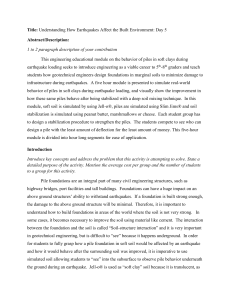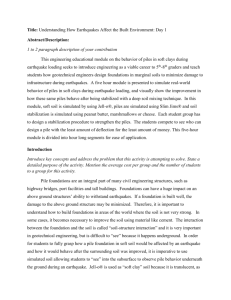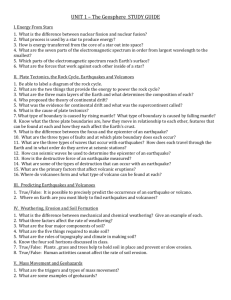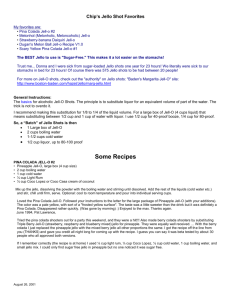NEES_Hub_Assessment_Day2
advertisement
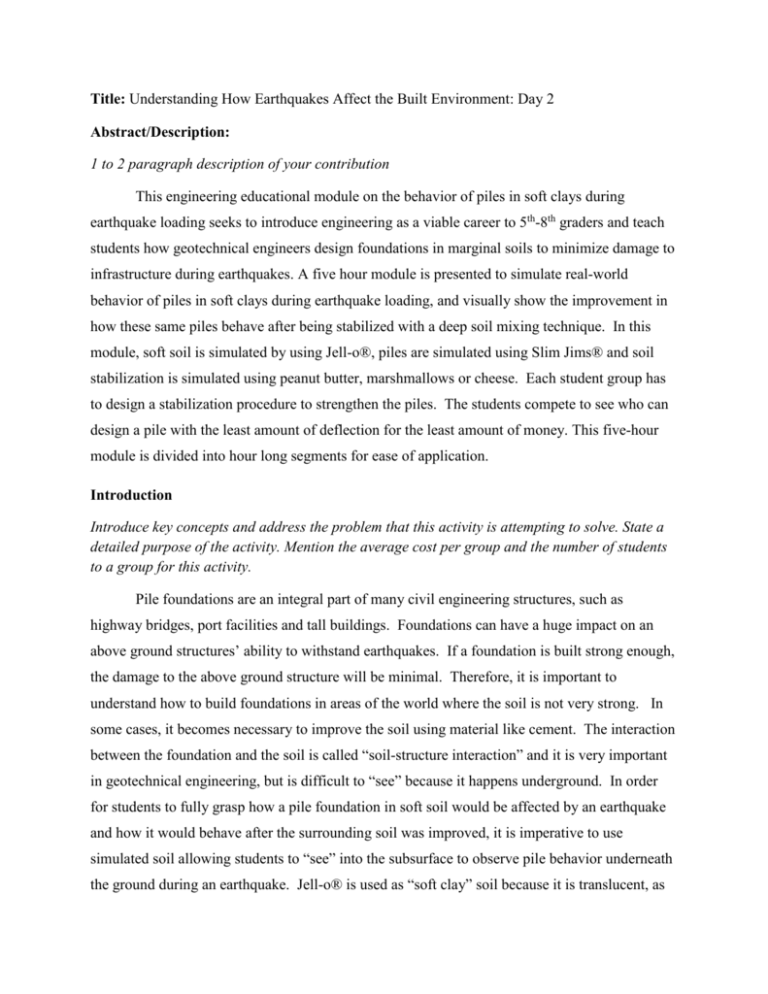
Title: Understanding How Earthquakes Affect the Built Environment: Day 2 Abstract/Description: 1 to 2 paragraph description of your contribution This engineering educational module on the behavior of piles in soft clays during earthquake loading seeks to introduce engineering as a viable career to 5th-8th graders and teach students how geotechnical engineers design foundations in marginal soils to minimize damage to infrastructure during earthquakes. A five hour module is presented to simulate real-world behavior of piles in soft clays during earthquake loading, and visually show the improvement in how these same piles behave after being stabilized with a deep soil mixing technique. In this module, soft soil is simulated by using Jell-o®, piles are simulated using Slim Jims® and soil stabilization is simulated using peanut butter, marshmallows or cheese. Each student group has to design a stabilization procedure to strengthen the piles. The students compete to see who can design a pile with the least amount of deflection for the least amount of money. This five-hour module is divided into hour long segments for ease of application. Introduction Introduce key concepts and address the problem that this activity is attempting to solve. State a detailed purpose of the activity. Mention the average cost per group and the number of students to a group for this activity. Pile foundations are an integral part of many civil engineering structures, such as highway bridges, port facilities and tall buildings. Foundations can have a huge impact on an above ground structures’ ability to withstand earthquakes. If a foundation is built strong enough, the damage to the above ground structure will be minimal. Therefore, it is important to understand how to build foundations in areas of the world where the soil is not very strong. In some cases, it becomes necessary to improve the soil using material like cement. The interaction between the foundation and the soil is called “soil-structure interaction” and it is very important in geotechnical engineering, but is difficult to “see” because it happens underground. In order for students to fully grasp how a pile foundation in soft soil would be affected by an earthquake and how it would behave after the surrounding soil was improved, it is imperative to use simulated soil allowing students to “see” into the subsurface to observe pile behavior underneath the ground during an earthquake. Jell-o® is used as “soft clay” soil because it is translucent, as well as soft enough to show adequate deflections in an unimproved pile. Slim Jims® (beef jerky) are the pile material, creamy and crunchy peanut butter, small and large marshmallows, as well as sharp cheddar cheese are the stabilizing material to improve the pile performance, and Lollipops are inserted into the top of the Slim Jim® piles to simulate a structure. The students compete to see who can design a pile with the least amount of deflection for the least amount of money using a predetermined cost list and an optimization equation. This module can be administered to a class size as small as 5 to as large as 35 (or more) with enough help. The larger the class, the more Jell-o has to be made. The average 2011 cost per group, including all supplies and after a shaker has been built, is roughly $10, although this cost can be offset by having each student bring in a plastic tub, a box of Jell-o and some excavating spoons. Earthquake Engineering Component How does the goal of this activity relate to the mitigation of damage due to natural disasters such as liquefaction, tsunamis and earthquakes? How does your model relate to real life examples of what earthquake engineers and scientists do? Why is your model relevant to the field of earthquake engineering? The goal of this activity is to teach students about geotechnical engineering and strengthening foundations to lessen movements and therefore, damages, due to earthquakes. The model is a direct comparison to real-life examples of improving the behavior of bridges built in soft soil by using cement deep soil mixing to strengthen the existing pile foundations. In this case, the cement deep soil mixing is simulated using a variety of edible materials with different cohesive and strength properties, such as cheese, peanut butter and marshmallows. This model is relevant to the field of earthquake engineering because every year, thousands of people lose their lives due to structure collapses during and after earthquakes. Many of these collapses could be prevented by building better foundation systems. Objectives and Standards: A detailed itemized list of reading, writing, and scientific objectives and state the reading writing and subject national/state standard and the appropriate codes/grade levels. The specific learning outcomes of this module are to: 1. Learn the importance of geotechnical engineering and foundation systems in keeping structures safe during earthquakes. 2. Improve a zone of soft soil around piles to reduce movement, therefore, minimizing earthquake induced damage. 3. Gain insight into geotechnical engineering to broaden career path opportunities. 4. Improve the perceptions of engineers and the engineering profession. The standards pertaining to Day 2 of this module are as follows: OAC 210:15-3-78: Standards for Inquiry, Physical, Life, and Earth/Space Science Process Standard 1.1. Identify qualitative and/or quantitative changes given conditions (e.g., temperature, mass, volume, time, position, length) before, during, and after an event. Process Standard 1.2. Use appropriate tools (e.g., metric ruler, graduated cylinder, thermometer, balances, spring scales, stopwatches, computers, hand held data collection devices) to measure objects, organisms, and/or events. Process Standard 1.3. Use appropriate International System of Units (SI) (i.e., grams, meters, liters, degrees Celsius, and seconds); and SI prefixes (i.e. milli-, centi-, and kilo-) when measuring objects, organisms and/or events. Process Standard 3.1. Ask questions about the world and design investigations that lead to scientific inquiry. Identify testable questions based on prior knowledge, background research, or observations. Process Standard 3.2. Evaluate the design of a scientific investigation. Process Standard 3.3. Identify variables and/or controls in an experimental setup: independent variable and dependent variable. Process Standard 3.4. Identify a testable hypothesis for an experiment. Process Standard 3.6. Recognize potential hazards and practice safety procedures in all science activities. Process Standard 5.1. Ask questions that can be answered through scientific investigation. Process Standard 5.3. Use the engineering design process to address a problem or need (e.g., identify a need, conduct background research, prepare preliminary designs, build and test a prototype, test and revise design, communicate results). Process Standard 5.5. Develop a logical relationship between evidence and explanation to form and communicate a valid conclusion, and suggest alternative explanation. PHYSICAL SCIENCE Standard 2:1. The motion of an object can be measured. The position of an object, its speed and direction can be represented on a graph. OAC 210:15-3-46.1: MATHEMATICS: Grades 6 - 8 Process Standard 1:5. Apply a variety of strategies (e.g., restate the problem, look for a pattern, diagrams, solve a simpler problem, work backwards, trial and error) to solve problems, with emphasis on multistep and non-routine problems. Process Standard 2.2. Reflect on and justify reasoning in mathematical problem solving (e.g., convince, demonstrate, formulate). Process Standard 2.3. Select and use appropriate terminology when discussing mathematical concepts and ideas. Process Standard 3.1. Identify and extend patterns and use experiences and observations to make suppositions. Process Standard 3.2. Use counter examples to disprove suppositions (e.g., all squares are rectangles, but are all rectangles squares?). Process Standard 3.3. Develop and evaluate mathematical arguments (e.g., agree or disagree with the reasoning of other classmates and explain why). Process Standard 4.1. Apply mathematical strategies to solve problems that arise from other disciplines and the real world. Material List A detailed itemized list of materials needed for Day 2 with specified quantities. Jell-o® tub: (1) Plastic, Dimensions: 15" X 11-1/2" X 6" Figure 1: 15" X 11-1/2" X 6" Plastic Jell-o® tub with 6 Piles; Jell-o® Depth = 3” Jell-o®: (117 ounces: Each tub contains 13-3 oz boxes = 39 ounces per tub + 12 cups or 3 liters of boiling water+ 14 cups or 3.5 liters of cold water) Demonstration – 1 tub (39 ounces) Slim-Jims: diameter=1 cm (0.39 inches), length=9.5 cm (3.74 inches) Demonstration – 1 Soil (Jell-o Stabilization) – Teacher Choice of one or more of the following o Cheese (1 block): Multiple molds can be cut out of 1 block to suffice for all three aspects of the experiment (Demonstration, Jell-o®-play and Final Design) o Creamy and Crunchy Peanut Butter: (8 oz of each – about ½ of a regularly sized peanut butter container) o Small and Large Marshmallows: (6 of each, depending on final designs) Lollipops Demonstration – 1 Figure 2: Picture of the Cheese, Large Marshmallow, Slim Jim ®, and Lollipop Used in the Module. Excavation molds: 1 of each size Table 1: Aluminum and Plastic Excavation Mold Dimensions. Mold A B C D E F G D (cm) 0.84 3.00 3.00 3.63 4.88 6.15 7.75 L (cm) 8.92 3.02 6.12 4.60 6.02 10.21 10.16 V(cm3) 4.8 21.3 43 47.4 112.7 304.2 479.2 Figure 3: Excavation Molds: From left to right, G, F, E, D, C, B, A. Shaker A simple shaker was designed and built for roughly $26 (October 2010). The shaker was made out of plywood, toilet partition, drawer pulls, a steel rod, a ¾ inch steel washer and some nuts and bolts. There was some welding involved to make the bearing of the shaker, however, this part could be manufactured with simple nuts and bolts, alleviating the need for a machine shop and welder. A variable speed cordless drill can be attached to this bearing and used to shake the system at many different frequencies depending on the speed chosen, or a hand crank could be attached to manually shake the system. The closer the hole is to the center, the smaller the amplitude, and the farther away the hole is to the center, the larger the amplitude. This is a very economical and efficient shaker to simulate earthquakes in the school setting (Figure 4). Figure 4: Low Cost Earthquake Simulator (designed and built by Mr. Michael W. Leary, owner AM Squared Construction Services, LLC). Procedure: List the steps needed to complete the activity. Make sure your directions are clear. If there are any assessments during the activity, make sure to list them. If there are some steps/materials that can be optional, indicate this. Day two of the classroom visits (Duration: 50 min-1 class period) 1- Demonstration of the Equipment a. Define the model i. We are going to look at bridges 1. Have pictures of different kinds of bridges. - maybe some with earthquake damage 2. What kinds of bridges do you see around where you live? 3. What if you have a bridge on piles in an area prone to earthquakes? ii. Jell-o® (in a transparent plastic container), Slim Jim® , will be used to represent soft clay, piles b. Earthquakes will be simulated using a small shaker. Demonstrate an earthquake effect on pile foundations of bridges with just the Slim Jims® in the Jell-o® excited by the shaker (shaking table). c. What could we do to reduce the bridge displacements and consequently damages caused by the earthquake? - they might suggest different kind of bridge, different material for piles, larger size of piles, d. But what if there are already 1000's of bridges built and it is too expensive to rebuild them all? e. Another option is to improve the soil around the piles (retrofitting). This can also be done before a new bridge is built. i. Have a moderately successful ground modification material on hand to demonstrate (e.g. peanut butter). You don’t want the students to be influenced by the material you chose for the demonstration. ii. Demonstrate the excavation techniques, pile driving, and ground improvement techniques as well. f. The parameters for their experiment will be defined. i. Next class you will be going through the engineering design process to test different materials that could be used in our model for the soil improvement. You will have time to try different materials as you develop a final design to be tested on the last day of our session. 2- The teacher will divide the students into groups. Resources. Cite resources with appropriate links that were used for your activity. If your materials are something that should be ordered from a specific website, indicate this here. A full report on this module is given here: Cerato, A.B., Taghavi, A., Muraleetharan, K.K. and Miller, G.A. (2011). Understanding and Improving the Seismic Behavior of Pile Foundations in Soft Clays: An Educational Module. Report submitted to NEES-Comm, 80 pp. (https://nees.org/resources/2705) Assessment. If possible include examples(i.e.,) sentences of how these keywords are used. List any preembedded or post activity assessments here. Jell-o Activity Day 2: 1. When we began our demonstration, the Slim Jim pile foundation was built in a Jell-o mold with no improvements. a. Describe what happened to the pile foundation when the Jell-o was subject to dynamic loading (earthquake simulation). b. Describe how modifying the soil (jello) changed the behavior of the pile foundation when it was subject to dynamic loading (earthquake simulation). 2. Describe how earthquakes create bridge displacements and potentially cause damage to bridges. 3. Describe two potential methods for decreasing bridge displacements “at risk” from a potential earthquake. 4. What stabilizing material do you think will work the best in minimizing the pile movements? Extensions. How can this activity be connected to real life example? What additional assessments/procedures can be added to your activity? What additional test can be performed? How is this extension related to the original activity? If there are any additional materials used here, make sure to list them as optional in the material list section. This module is based on real life examples. Every structure built on this earth as some sort of foundation system, anchoring that structure to the ground. Buildings without adequate foundations in seismically active areas do not fare well. However all the public sees is the damage to the above ground structure, and thinks that if the above ground structure is made stronger it will fare better during earthquakes. While partially true, if the foundation system is not strong, no matter how strong the structure is built, it will always fail. The foundation system strength and flexibility is one of the major keys to building earthquake resistant structures, and introducing the concept of geotechnical engineering into middle schools can help to educate our future workforce. Scaling. If this activity can be scaled for a different grade level, indicate how it can be scaled and the appropriate grade level/standard codes. This module could also be used at various educational levels, from elementary to high school, as well as at the undergraduate level, with appropriate modifications. For example, in elementary school, the Jell-o play (Day 3) and Jell-o design (Day 4) could be the highlights of the module, whereas, in high school, the science behind soil stabilization could be stressed more, while still allowing the students to play with the Jell-o and stabilization procedures.
